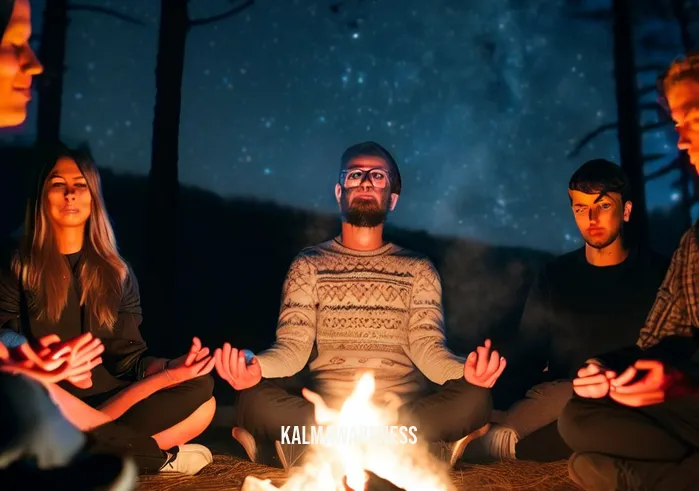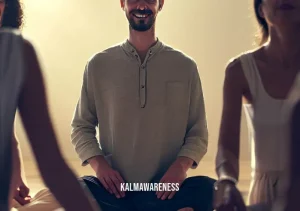The Power of Meditation to Find Lost Items: A Deep Dive into Mindfulness and More
Have you ever lost an item and spent what felt like hours searching for it, only to find it in the most unexpected place? It happens to the best of us. While some dismiss these events as mere moments of forgetfulness, there’s a deeper understanding to be achieved. The art of meditation to find lost items is not just a metaphorical concept but a practical approach rooted in Mindfulness, Concentration, Visualization, Memory, and Self-awareness.
Mindfulness: The Foundation of Finding
Mindfulness is not just a buzzword. It’s a way of life that has its roots in ancient practices, offering us the tools to be present in the moment. When you’re searching for lost items, it’s easy to get frustrated or be consumed by other thoughts, making the search even harder. The solution? Mindful movement. By focusing on each step and movement, you become more attuned to your surroundings and can often notice things you might have overlooked.
Concentration: The Beam that Lights the Way
In our daily lives, we’re constantly bombarded with information. Our attention spans have dwindled, making it easy to lose items and hard to find them again. Cultivating concentration is like shining a flashlight in a dark room. It illuminates the path. A deep understanding of how to stabilize our minds can lead us to be more purposeful in our searches and daily activities.
Visualization: Seeing Beyond the Obvious
Have you ever heard of the term ‘third eye’? It represents the idea of seeing beyond the obvious, an aspect crucial when searching for lost items. Through practices like mirror gazing, one can cultivate a strong sense of visualization. This isn’t about supernatural powers but training the mind to remember and recreate mental images, assisting in recalling where you might have placed an item.
Memory: The Vault of Past Actions
It’s a common saying that our mind is like a steel trap. But sometimes, the trap seems a bit rusty. Enhancing our memory can be achieved by diving into practices that help train your mind to be stronger than your feelings. By doing so, the recollection becomes a smoother process, reducing the instances of misplaced items and the anxiety associated with it.
Self-awareness: The Inner Compass
Lastly, the compass that often guides us to our lost treasures is self-awareness. By understanding ourselves, our habits, our spaces, and our routines, we can often predict where items might be. Sustainable self-care plays a pivotal role in enhancing this self-awareness, making our searches less about frantic looking and more about intuitive finding.
Incorporating these practices into our lives doesn’t just aid in finding lost items, but it can also profoundly impact our overall well-being. Techniques like breathing and meditation are not just for spiritual seekers but for anyone aiming to lead a balanced life. Especially in today’s fast-paced world, a moment of stillness, whether it’s through hypnobirthing for expectant mothers or simple gratitude meditation before sleep, can make a world of difference.
But how does one begin this journey? For novices, starting with resources like Jack Kornfield’s meditation for beginners can be an excellent step. Meanwhile, those looking for daily inspiration can immerse themselves in practices one for each blessed day.
By now, you must be wondering about the intricate ways these elements interplay and how to seamlessly integrate them into daily routines. Worry not! As we proceed, we will delve deeper into the practical aspects, ensuring that by the end, not only will you be better equipped to find those elusive lost items but also lead a more centered life.
Curious about specific meditation techniques to locate lost items and the science behind them? Continue reading in the next segment where we’ll dissect these methods, ensuring you’re armed with tools and knowledge for both the tangible and intangible quests of life.

Unearthing the Techniques: Meditation to Retrieve Lost Items
In the world of meditation, there are countless techniques designed for specific purposes. One unique purpose that often goes underappreciated is using meditation to find lost items. While our introductory chapter provided an overview, let’s delve deeper into the specific meditation methods that can enhance our intuitive abilities. Through the guidance of techniques, tables, and lists, this chapter aims to provide a thorough exploration for those intrigued by the concept.
The Multifaceted Approaches to Meditation
Before we venture into the techniques, it’s worth acknowledging that there isn’t a one-size-fits-all approach. Much like how deep we get into meditation varies based on the method, the efficacy of using meditation to locate lost items depends on the technique and the individual.
Here are a few broad categories of meditation techniques:
- Mindful Awareness: Grounding exercises to develop present-moment awareness.
- Visualization Meditation: Focusing on mental images to stimulate memory recall.
- Concentration Meditation: Training the mind to focus without distractions.
- Body Awareness Meditation: Cultivating heightened awareness of bodily sensations. A good resource for this is the Touch that body part meditation.
The Power of Setting Intentions
In the vast world of meditation, setting a specific intention is paramount. When you’re aiming to find lost items, channeling your meditation sessions with a clear intention can work wonders. For those seeking daily nudges, judgement of the wise provides insights on setting and understanding intentions in our daily meditative practices.
The Meditation Techniques Overview Table
To better understand the relationship between various meditation techniques and their impact on finding lost items, let’s delve into the table below:
| Meditation Type | Primary Benefit | Related Link for Deep Dive |
|---|---|---|
| Mindful Awareness | Enhanced present-moment cognition | Mindful Hypnobirthing |
| Visualization Meditation | Stimulated mental imagery and recall | Meditation Made Simple |
| Concentration Meditation | Reduced distractions, heightened focus | Attaining a peaceful state of mind |
| Body Awareness Meditation | Greater body-mind connection | Rouse Yoga Techniques |
Practical Steps: Embracing the Meditation Journey
For those keen on integrating these techniques into daily routines, here’s a brief roadmap:
- Start Small: As with any practice, start with short sessions. Over time, as comfort grows, gradually extend your meditation duration.
- Set Clear Intentions: Before each session, mentally articulate your purpose. In this context, it would be about recalling where the lost item might be.
- Explore Techniques: Don’t restrict yourself to one method. The versatility in meditation exercises allows for personal adaptation.
- Consistency is Key: Meditating sporadically won’t yield optimal results. Establish a routine, whether it’s daily or weekly.
- Seek Guidance: For those unfamiliar, starting with guided sessions or resources like meditation for beginners can be beneficial.
It’s remarkable how a practice rooted in stillness can actively assist in the tangible task of finding lost items. By marrying age-old wisdom with contemporary challenges, meditation proves its versatility and relevance yet again.
As our exploration deepens, what awaits in the next chapter is a closer look at the science behind these techniques. How does the brain respond when we meditate? And how does that influence our ability to find misplaced objects? Stay tuned, for the journey into the nexus of neuroscience and meditation promises to be a fascinating one. Continue reading to uncover these secrets.
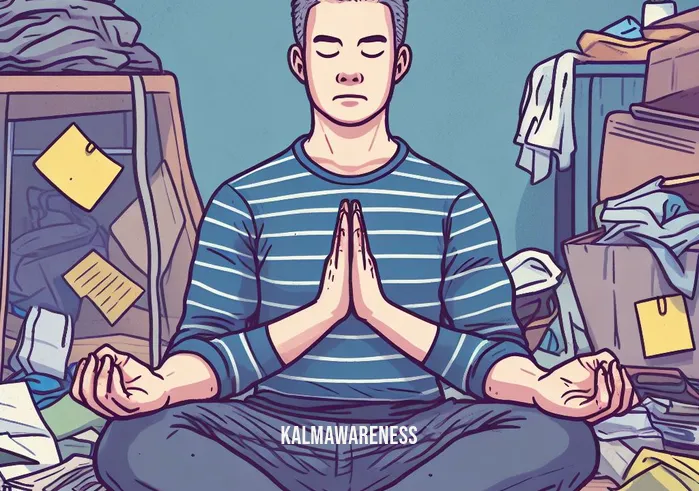
Echoes of Hope: Stories of Meditation Leading to Discovery
While the logic behind using meditation to find lost items has been discussed in previous chapters, the heart of the matter lies in the inspirational tales of individuals who’ve experienced its magic. There’s an age-old saying, “Where logic can take us to a conclusion, a story can take us on a journey.” This chapter will take readers through heartfelt stories, embedding hope, showcasing the power of meditation in reclaiming lost treasures, both tangible and intangible.
Sarah’s Silver Locket: More Than Just an Ornament
Sarah, a young woman, lost her grandmother’s silver locket, an heirloom passed down through generations. Distraught, she remembered reading about how meditation can stabilize the mind. Deciding to give it a shot, she sat down, took deep breaths, and visualized the last time she wore it. Not only did she recall placing it in an old jewelry box, but the meditation also evoked cherished memories of her grandmother, making the find emotionally enriching.
“In the quietude of meditation, I found more than a locket; I found memories that were lost to time.” – Sarah
Tom’s Travel Tales: Lost Passport, Found Purpose
Tom was backpacking across Europe when he misplaced his passport. Panic set in, with a flight scheduled in two days. Recalling a teenagers walking meditation, he walked around the city, being completely mindful. By the end of his walk, he retraced his steps to a quaint café where the staff had kept his passport safe.
“It wasn’t just a passport I found that day; I discovered a city’s heartbeat and its kindness. All because I walked, mindfully.” – Tom
Maria’s Music Sheets: From Despair to Symphony
Maria, an upcoming musician, misplaced her self-written music sheets a week before her big concert. Having recently explored the spiritual benefits of mirror gazing, she decided to meditate, gazing into her reflection, seeking answers. The meditation evoked a vision of her placing sheets inside a book for safekeeping. The joy of finding her sheets was immense, but the journey of self-reflection was her true takeaway.
“The notes were vital, but the melody of self-awareness was the real find.” – Maria
Drawing Inspiration: The Larger Implication
These stories aren’t merely about finding lost items; they resonate with a deeper philosophy. It’s about hope, perseverance, and the belief that solutions often lie within us. As observed in meditative practices for sustainable self-care, the calm evoked through meditation can often lead to clarity, enabling solutions to problems that seemed insurmountable.
“What we seek is often closer than we think, hidden in the recesses of our mind, waiting to be unveiled through meditation.” – Anonymous
Moving Forward: Embracing Meditation Beyond Retrieval
While these inspirational tales revolve around using meditation to find lost items, the underlying message is evident. Meditation is more than just a tool for retrieval; it’s a journey of self-discovery, hope, and inner peace. And as we inch closer to understanding its depth, we unearth aspects of ourselves that were hitherto unknown.
As we journey forward, the next chapter delves into the nuances of creating a conducive environment for meditation. After all, the ambiance plays a pivotal role in enhancing the meditative experience. Ready to design your meditative space? Let’s venture into creating sanctuaries that resonate with tranquility in the next segment. Continue reading to craft your personal oasis of calm.
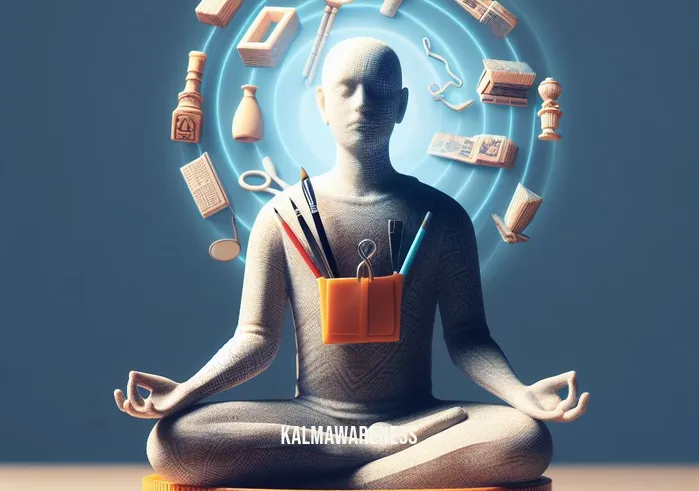
The Meditation Mechanics: A Step-by-Step Guide to Retrieving Lost Items
While stories and theories are inspiring, what we often need is a tangible, actionable guide. Meditation to find lost items isn’t just about sitting down and hoping for the best. It involves precise steps, tailored techniques, and conscious efforts. In this chapter, we’ll break down the process using lists and bullet points, offering readers a structured pathway to harnessing the power of meditation for retrieval.
The Five Fundamental Pillars
Before diving into the steps, it’s essential to grasp the foundational pillars of this meditative practice:
Focus: Channeling your attention solely on the act of retrieval.
Intent: Setting a clear, unwavering goal of finding the lost item.
Relaxation: Ensuring the body and mind are in a state of complete relaxation. The practice of meditating while lying down can be particularly helpful in achieving this.
Visualization: Activating the mind’s eye to replay past events or actions related to the lost item.
Trust: Letting go of doubts and trusting the process.
Step-by-Step Meditation Guide to Find Lost Items
Prepare Your Space:
- Choose a quiet location, free from distractions.
- Ensure you’re seated or lying down comfortably. If you’re exploring meditation for the first time, resources like Meditation for Beginners can be insightful.
Close Your Eyes and Breathe:
- Focus on your breathing pattern, taking deep inhales and exhales.
- Use the breathing meditation technique to deepen relaxation.
Set Your Intention:
- Clearly state in your mind what you’re searching for.
- Remember, specificity is vital.
Visualize Past Actions:
- Retrace your steps in your mind from the last time you remember having the item.
- Pay attention to details: surroundings, feelings, or any peculiar observations.
Trust Your Intuition:
- If your mind drifts to a particular location or scenario, trust it. It’s often the subconscious providing clues.
Conclude the Meditation:
- Gradually bring your awareness back to the present moment, keeping in mind any insights or clues your meditation revealed.
Act on Your Insights:
- Once done, act on any feelings, hunches, or explicit recollections that came up during the meditation.
Additional Tips for Effective Meditation
Stay consistent. If you don’t find success in your first session, don’t be disheartened. Remember the insight from how deep and fast meditation impacts us. It might take time, but it’s often fruitful.
Ensure you’re in a calm state of mind before you begin. Being anxious or stressed can cloud intuition.
Maintain a journal. Post meditation, jot down any insights or visions. Over time, this can help in understanding patterns.
What Lies Beyond Retrieval
Meditation for finding lost items is a doorway. While it serves an immediate purpose, the skills and insights garnered extend beyond mere retrieval. They promote heightened self-awareness, improved memory, and a deeper connection with one’s intuition.
As we move towards concluding our exploration, the final chapter will tie together all these threads, focusing on the holistic benefits of meditation, beyond the realm of finding lost items. How does this practice reshape our lives? How can we integrate it into our daily routines for a sustained impact? Dive into the next chapter to unravel these answers and more, culminating our enlightening journey.
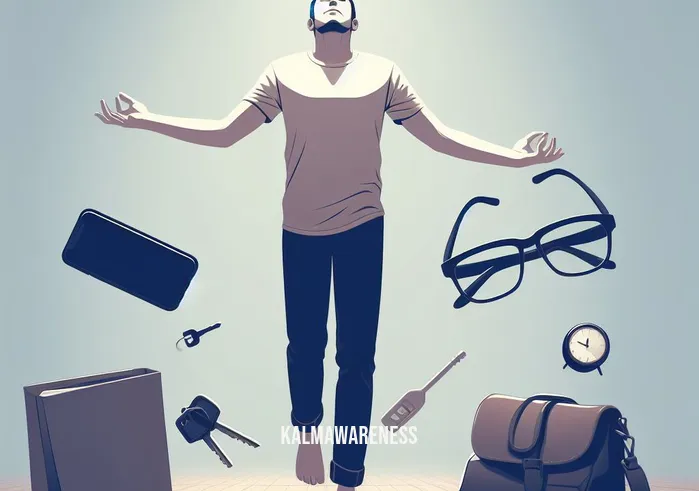
The Journey’s End: Reflecting on Meditation’s Power to Retrieve and Reconnect
As our exploration on using meditation to find lost items reaches its conclusion, it’s worth taking a moment to reflect on the path traveled. Meditation, often perceived as a tool for spiritual seekers, has shown itself to be a practical aid for everyday challenges, like locating that elusive set of keys or that cherished piece of jewelry.
The Layers Unraveled
Our journey began with understanding the foundational concepts, from Mindfulness to Self-awareness. We then took inspiration from real-life stories, reminding ourselves that hope often shines brightest when situations seem bleak. By breaking down the process step-by-step, we equipped ourselves with actionable tools, ready to be applied at a moment’s notice.
One cannot ignore the profound impact sustainable self-care practices have on our well-being. By engaging in these practices, we not only enhance our ability to find lost items but also cultivate a deeper relationship with our inner selves.
Beyond the Tangible
While the immediate goal might be to locate a missing item, the deeper essence lies in connecting with our subconscious, understanding patterns, and fostering self-awareness. Remember the wisdom offered in judgement of the wise; it’s often the journey that enlightens, more than the destination.
Your Next Steps: A World Awaiting Exploration
This guide on using meditation to find lost items is just a snippet of the vast world of mindfulness and introspection. Here’s what you can do next:
Revisit and Reflect: Sometimes, revisiting sections like Breaking it Down can offer fresh insights upon a second read.
Explore More: Our platform is brimming with content. Dive into the nuances of Mindful Movement or explore what it truly means when something will happen ‘pretty soon’.
Practice Makes Perfect: The more you meditate with intent, the better you get. Remember, consistency is key.
A Note of Gratitude
To our esteemed readers, a heartfelt thank you for embarking on this journey with us. Your curiosity, openness to learn, and the time invested in understanding meditation’s multifaceted nature are sincerely appreciated. We assure you of many more such enlightening journeys in future editions.
In the ever-evolving world of mindfulness, there’s always something new to discover, a fresh perspective to consider. So, until next time, keep meditating, keep exploring, and remember – what’s lost today could well be an opportunity for a profound self-discovery tomorrow.
Stay mindful and see you soon in our next enlightening journey!

